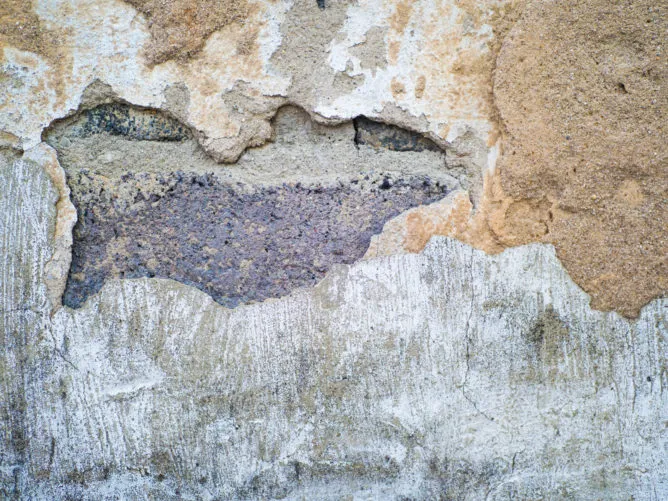A property built between 1960 and 1999 likely contains asbestos, a hazardous material often found in walls.
Asbestos in walls
Asbestos was widely used in big cities to create large living spaces quickly and efficiently. It could be easily incorporated into prefabricated Eternit panels, lightweight panels, and plaster. As a material, it was thermally insulating, resilient, and fireproof, making it a popular construction choice. For a long time, asbestos was considered a miracle fibre that could simultaneously fulfil several requirements for statics and fire protection. However, the health risks associated with the material were ignored for a long time despite its high carcinogenicity.
First, the good news is that it is typically securely bound when asbestos is present in solid and undamaged walls. This means that as long as the wall is not disturbed, it poses a relatively low risk. However, non-experts often need help determining whether asbestos is securely or weakly bound. To learn more about the difference between weakly and strongly bound asbestos fibres, please visit our blog post titled “Asbestos: What Is It?”
Asbestos walls can be problematic for many homeowners, landlords, and managers because they may not know whether asbestos-containing materials were used during construction. Additionally, even if they are aware, they may need to learn what type of asbestos was used. This is particularly common on farms, where there may be a long chain of inheritance and no clear record of what materials were used. As a result, asbestos can be present in the walls of houses, rental properties, barns, or factory buildings without anyone knowing it. In the past, asbestos was often used in these types of buildings because it was cost-effective, provided fire protection, and allowed for rapid construction. However, the dangers of asbestos are now well-known, and it is essential to take precautions to ensure that buildings do not contain this hazardous material.
Below are some of the conditions that make an examination of the walls essential:
- The walls show signs of damage (cracks / crumbling material, etc.)
- Renovation or refurbishment is to be carried out on a building constructed before 1999
- Suspicious lightweight walls with grey fibres
Asbestos in plaster
When discussing “asbestos in walls,” it is essential to consider the presence of asbestos in plaster. The good news is that similar to walls, asbestos is typically well-contained within plaster and is not readily released into the surrounding environment.
Despite the benefits of working on walls, several issues must be addressed. Many people are unaware of the possibility of asbestos hidden in the plaster. Drilling, sawing, and sanding are often done without any dust mask or respiratory protection. Even with improved energy efficiency measures, work is frequently done on the plaster. Therefore, it is important to remain cautious and take necessary precautions.
Workers are often oblivious to the problem, or untrained personnel are employed due to cost-cutting measures to undertake renovations or refurbishments. This problem is exacerbated by the fact that it is not only energy efficiency upgrades that necessitate working on plaster but also the most prevalent source of issues in homes, i.e. mould.
It is common for people to work on the plaster in their homes at some point, which often involves drilling and sanding. However, if the plaster contains asbestos, these activities can lead to extremely high levels of asbestos fibre contamination. This is why it is crucial to be aware of the risk and to take adequate protective measures before carrying out any work on the plaster. It is essential to check in advance whether the plaster contains asbestos or not to prevent any health hazards.
Asbestos in ceilings
It has already been discussed in the entry titled “Asbestos: Facades, Roofs and Driveways” that asbestos can be found in roofs. Hence, it is not surprising to find asbestos in walls, plaster, and ceilings within homes. Asbestos cardboard and lightweight asbestos boards are some common examples of such cases.
The asbestos board is an exceptionally high risk because its fibres are weakly bound. Unlike Eternit boards, which have firmly attached asbestos and can withstand prolonged exposure without releasing excessive amounts of asbestos fibres, the asbestos boards can release fibres even without significant additional exposure, thereby increasing contamination levels.
Often, Promabest boards were used to cover materials where fire protection was necessary, such as pipes, ventilation shafts, and cables.
General risk of asbestos
The danger of hidden hazards in interiors is significant as risks are often only discovered during work. Asbestos is rarely added to paint because most paints do not benefit from adding asbestos fibres.
During renovation work, it’s possible to come across a type of asbestos known as sprayed asbestos. This material was typically used for thermal insulation around pipes, cables, and steel structures. It looks similar to plaster and can be found in walls and ceilings. However, it poses a very high risk because it can contain up to 90% weakly bound asbestos fibres. These fibres can be released into the environment without direct exposure and quickly spread during processing. To avoid exposure, taking all necessary precautions when dealing with sprayed asbestos is essential.
The good news is that sprayed asbestos was banned in the UK in 1986, meaning buildings constructed after this year can no longer contain sprayed asbestos.
IVARIO offers asbestos test kits for house dust and materials. The tests can be carried out without prior knowledge and are analysed in an accredited laboratory. The results are conveniently available online.

